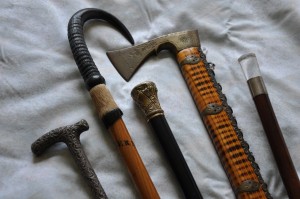Unusual Tops
In centuries past, well-heeled gentlemen, and ladies too, were seldom seen without a walking stick in hand. Unlike today, canes of the 17th, 18th and 19th centuries, often boasting handles of precious metals and jewels, served as symbols of wealth, power and social stature. They were much more a fashion accessory than walking aide.
Decorative canes, as the name implies, were the cane as fashion accessory in its purest form. Unlike their system cane counterparts, their function was for the most part aesthetic. The variety of materials and forms of these decorative canes was limited only by the imagination of highly trained artisans and craftsmen. Ivory, gold, silver, porcelain, jewels, enamel and even glass were just a few of the materials employed in creating formal, decorative walking sticks.
The decorative canes available to collectors today are those hailing primarily from the second half of the 19th century and into the 1920s. Most decorative canes have a plain shaft with a decorative handle crafted from a variety of materials.
Silver handles were widely produced during this time period and are easily obtained making them a good starting point for a decorative cane collection. Finely chased sterling and gold knob handles were often inscribed and used as presentation sticks while even fancier sterling knobs might take the form of animals, human figures or elaborate crook handles. The Art Nouveau period produced some extraordinary sterling-handled canes .
Ivory was a favorite medium for cane artisans who carved fabulous handles of every shape and form. Because of its rarity, however, ivory sticks were generally only attainable by the wealthiest members
of society. Among the rarest and most expensive examples are those canes carved completely of ivory. More than any other material, ivory handles offer the greatest variety of subjects to be found on cane handles. Practically every type of animal, from dogs to elephants, has been represented as well as every example of flower or mythical character and beast. Faces and human forms also had their place on the carved ivory cane handle. They continue to be enormously popular among collectors, especially examples that are embellished with glass eyes or jewels.
Because of their high cost, canes with gold handles are among the rarest. Many canes carved from less expensive materials will have an ornate gold collar as an accent. Most gold handled canes were made for evening use and will usually have an ebony or equally elegant shaft.
Porcelain handles produced by renowned makers such as Meissen and Sèvres are highly collectible due to their extraordinary beauty and rarity. Because they are so fragile, most porcelain handles were damaged over the years and are difficult to find in mint condition.
Other materials used to craft handles and shafts for decorative canes included tortoise shell, bone, antler, brass, bronze, wood, snakeskin, leather, sharkskin, and even glass.
Perhaps the most important canes on the market today are those that were produced by elite houses such as Fabergé and Tiffany. These canes, often encrusted with diamonds and jewels, can command prices well over $15,000 and are most certainly considered the prize of any collection. The shop of Fabergé was known for its intricate enamel and diamond handles while Tiffany produced elegant gold handles with shining ebony or handsome tortoise shell shafts. Due to the variety of decorative canes, the collector can build upon a number of variations. Erotic canes, depicting nude forms, carved from ivory or cast in sterling. Even sticks whose decorative material may be somewhat less than appealing can bring high prices based on its rarity. One such stick is the bull’s penis cane which, aptly named, is covered from top to bottom wtih the phallic skin of one very unlucky bull.
